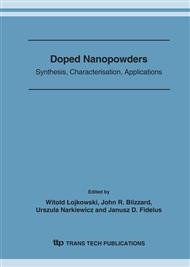p.25
p.31
p.41
p.47
p.53
p.61
p.73
p.81
p.89
Comparative Analysis of ZnS:Mn2+ Nanophosphors Prepared by Hydrothermal and Low Temperature Precipitation Methods
Abstract:
Manganese-doped ZnS nanophosphors were synthesized by two different methods: hydrothermal and low-temperature precipitation methods. The nanophosphors prepared by the hydrothermal precipitation and low-temperature methods had the size of 20 nm and 4 nm, respectively, and both were the cubic phase. The emission intensity of the nanophosphor prepared by the hydrothermal method was optimized at 10 mole % of Mn2+ concentration whereas that by low-temperature precipitation method was optimized at 3 mole % of Mn2+. The precipitationprepared nanophosphor, of size 4nm, showed a blueshift in the excitation spectrum and a redshift in the emission spectrum compared to the hydrothermal-prepared 20 nm nanophosphor. These phenomena can be explained in terms of the quantum confinement effect. The decay times especially were lengthened with decreasing particle size. This can be explained in terms of the variation in the transition probability induced from the quantum confinement effect.
Info:
Periodical:
Pages:
53-58
Citation:
Online since:
October 2007
Authors:
Price:
Сopyright:
© 2007 Trans Tech Publications Ltd. All Rights Reserved
Share:
Citation:


